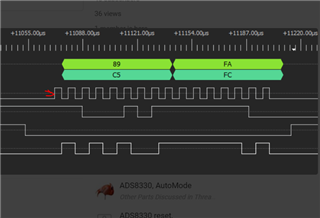I have been trying unsuccessfully to configure and verify the configuration register on the ADS8330. From the data sheet and other documents it appears the SPI should be CPOL = 0, CPHA = 1. When I try and write 0x5FD to the configuration register, I read back 0x9FA. The waveforms are shown below. Been fighting this for a bit so any help would be greatly appreciated. (Note: I have also tried CPHA = 0 with no luck there either)



